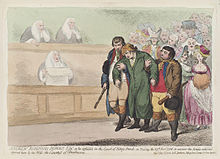Andrew Robinson Stoney

Pour les articles homonymes, voir Andrew Robinson, Robinson et Stoney.


Cette section ou cet article est une traduction incomplète ().
Vous pouvez modifier la page pour effectuer la traduction.

| Membre du 15e Parlement de Grande-Bretagne (d) |
|---|
| Naissance |  |
|---|---|
| Décès | |
| Nationalité | irlandaise  |
| Activité | |
| Père | George Stoney (d)  |
| Mère | Eliza Johnston (d)  |
| Conjoints | Hannah Newton (d) (à partir de ) Mary Eleanor Bowes (à partir de )  |
| Enfants | Mary Bowes (d) William Johnstone Bowes (d)  |
modifier - modifier le code - modifier Wikidata
Andrew Robinson Stoney, devenu après son mariage Andrew Robinson Stoney Bowes, né en 1747 et mort en 1810[1], est un aventurier anglo-irlandais, époux de la comtesse Mary Bowes de Strathmore, une ancêtre de la reine Élisabeth II du Royaume-Uni. La comtesse Bowes est célèbre sous le surnom de « la comtesse malheureuse » (« The Unhappy Countess ») en raison de sa relation houleuse avec Stoney, se terminant par un scandale.
L'histoire de Stoney Bowes et de la Comtesse de Strathmore inspire le romancier William Makepeace Thackeray qui en fait une autobiographie fictive publiée en 1844, intitulée Mémoires de Barry Lyndon. Le cinéaste Stanley Kubrick adapte ce roman dans son film Barry Lyndon en 1975. Ce film est en 1976 récompensé par quatre oscars : meilleure direction artistique, meilleure photographie, meilleure création de costumes et meilleure partition de chansons et adaptation musicale.

Texte anglais à traduire :
Mariage avec Mary Eleanor Bowes
Mary Eleanor Bowes, la veuve Comtesse de Strathmore et Kinghorne, était fiancée à son amant, George Gray, à l’été 1777 quand elle rencontra le charmant et rusé aventurier Anglo-Irlandais, Andrew Robinson Stoney, qui se frayait un chemin dans sa maison et son lit. Se faisant appelé Capitaine Stoney — bien qu’il n’était en réalité qu’un simple lieutenant dans la British Army — il insista pour combattre en duel pour l’honneur de Mary le rédacteur en chef du Morning Post newspaper qui avait publié des articles calomnieux sur sa vie privée. En fait, il avait lui même écrit les articles qui la critiquaient, ainsi que ceux qui la défendaient; et le duel entre Stoney et le rédacteur en chef a probablement été mis en scène. Prétendant être mortellement blessé, Stoney persuada la comtesse de l’épouser, étant sa dernière volonté, elle accepta. Il fut porté à l’hôtel sur une civière pour son mariage avec la comtesse le 17 janvier 1777. Mettant en scène un rétablissement miraculeux juste après le mariage, Stoney pris le nom de famille de sa femme (comme stipulé par les volontés de son père) et était désormais Andrew Robinson Stoney Bowes. Il servit en tant que High Sheriff of Durham en 1780 et fut élut député pour Newcastle plus tard la même année servant jusqu’à ce qu’il perde les prochaines élections en 1784.
Stoney's first wife, Hannah, was the daughter of William Newton of Burnopfield. It was widely believed that Stoney Bowes had caused her death in order to assume her inheritance. After his marriage to the Countess, he behaved brutally towards her. When he discovered that she had secretly made a pre-nuptial agreement safeguarding the profits of her estate for her own use, he forced her to sign a revocation handing control to him. Among other outrages, he imprisoned her in her own house, and forced her and one of her daughters to go into exile in Paris. They returned after a writ had been served on him. At the same time he raped the maids, invited prostitutes into the home and fathered numerous illegitimate children.
Mary Eleanor gave birth in August 1777 to a daughter Mary, most probably the child of her prior liaison with Gray. Bowes took the girl as his own child and the birth was registered as November 1777 but he later broadcast her illegitimacy. The couple had a son, William Johnstone Bowes, who was born on May 8, 1782.
Finally, in 1785, with the help of loyal maids, the countess managed to escape his custody and filed for divorce through the ecclesiastical courts. Having lost the first round of this courtroom battle, Stoney Bowes abducted Mary with the help of a gang of accomplices, carried her off to the north country, threatened to rape and to kill her, gagged and beat her, and carried her around the countryside on horseback in one of the coldest spells of the coldest winter of the century. The country was alerted, and Stoney Bowes was eventually arrested and the countess rescued.

Many years later, Thackeray learned of Stoney Bowes' life story from the Countess's grandson John Bowes and used it in his novel The Luck of Barry Lyndon.
Bibliographie
- (en) Arnold, Ralph, The Unhappy Countess (1957)
- (en) Foot, Jesse, The Lives of Andrew Robinson Bowes, Esq., and the Countess of Strathmore, written from thirty-three years professional attendance, from Letters and other well authenticated documents (1810)
- (en) Marshall, Rosalind K.. “Bowes, Mary Eleanor, countess of Strathmore and Kinghorne (1749–1800).” Oxford Dictionary of National Biography. Ed. H. C. G. Matthew and Brian Harrison. Oxford: OUP, 2004. 18 November 2006.
- (en) Parker, Derek, The Trampled Wife (2006)
- (en) Moore, Wendy, Wedlock: How Georgian Britain's Worst Husband Met his Match (2009)
Références
- ↑ Burke, Bernard, Sir, 1814-1892; Fox-Davies, Arthur Charles, 1871-1928. A genealogical and heraldic history of the landed gentry of Ireland. Harrison & Sons, Londres, 1912, p. 665.
Liens externes
- Notices d'autorité
 :
: - VIAF
- ISNI
- LCCN
- Pays-Bas
- NUKAT
- WorldCat
- Ressources relatives aux beaux-arts
 :
: - British Museum
- National Portrait Gallery
 Portail de l’Irlande
Portail de l’Irlande












